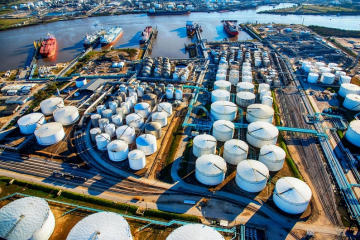It is now more important than ever for the oil and gas industry to embrace ESG strategies in its business model. Investing in ESG practices supports a business model that can sustainably operate for years to come.
As investor and societal pressures to report on environmental, social, and governance (ESG) topics are increasing, it is now more important than ever for the oil and gas industry to embrace ESG strategies in its business model and commit to transparency and disclosure. Since each company has a unique approach to ESG based on business-specific priorities, initiatives, and information requests, it is important to "own your own narrative" and develop clear messaging that shares your company's ESG story on your terms. It also has to be in a format that best resonates with your internal and external stakeholders. Thankfully, there are many tools and approaches to reporting that will enable you to effectively manage your ESG programs and balance the ever-growing demands of external stakeholders and rating agencies.
In this blog, we asked four of our experienced consultants to share perspectives and approaches to "owning your ESG narrative" - whether you're just getting started in the reporting space, or looking to expand upon your existing programs.
Bill's Perspective: Changes in how ESG is discussed in the oil & gas industry
Bill MacDonald is a Senior Vice President for Antea Group and its Oil and Gas Segment Leader.
Society’s desire to reduce its current dependence on fossil fuels and to move toward cleaner, more sustainable forms of energy is impacting how the investment community views the oil and gas industry. This has resulted in investor scrutiny of energy company ESG performance often through third-party rating firms, more selective investment decisions, and in some cases the shift of investments away from fossil fuels. The oil and gas industry response has been mixed. Many companies are embracing ESG strategies, developing metrics, and implementing the management structures necessary to oversee them, while others lag behind. But the trend is clear: investor and societal pressure demand that the oil and gas industry proactively address and communicate its progress related to ESG threats and opportunities to retain investor support and its license to operate. With access to capital that is key to survival in today’s marketplace, an effective program is more important than ever.
There are industry groups and forums to help you proactively participate in owning your ESG narrative as well as tools and resources available to advance your ESG business strategy. One opportunity would be to join The Environmental Partnership, a coalition of U.S. oil and natural gas companies dedicated to continuously improving the industry’s environmental performance. Another opportunity is to engage with IPIECA, an oil and gas focused industry association for advancing environmental and social performance. The Sustainability Accounting Standards Board (SASB) is a resource that provides tools to help businesses around the world identify, manage, and report on the sustainability topics that matter most to their investors.
There are many ESG related performance measures that can be addressed, but some common ones being addressed by oil and gas companies include water use and disposal, reducing methane, volatile organic compounds and carbon dioxide (CO2) emissions, reducing or eliminating flaring, increasing transparency around corporate governance and executive compensation, publishing employee health and safety training and performance metrics, community engagement, and sharing diversity and inclusion initiatives. Explore these and other topics that matter most to your business, community, and stakeholders, and you will be well on your way to owning your ESG narrative.
Danielle's Perspective: Considerations for first-time reporters
Danielle Pucherelli’s specializes in spill prevention countermeasure and control plans, stormwater management, baseline groundwater sampling, remediation, and air quality compliance for the oil and gas industry.
Creating an ESG report for your company is a process of not only compiling data but creating a voice and tone to convey the goals and mindset of your operations. This report has the potential to reach a wide variety of stakeholders in an oil and gas operator’s world: the customer, the investor, the employees, and the surrounding community. By articulating an accurate message of your company’s environmental and community goals as well as stating long-term values, you are setting the stage for the types of relationships and commitments you want to make to your community and workforce. It is important to take the time to really drill down a focused message and path for what you want your stakeholders to understand and know about your company.
Laura's Perspective: Starting with materiality
Laura Nelson leads Antea Group’s Corporate Reporting and Disclosure Solution and has specific expertise in corporate sustainability reporting, ESG disclosures, and materiality assessments.
Materiality is the name of the game when it comes to owning your narrative. It can be easy to get lost in a whirlwind of requests from customers, investors, and stakeholders that seemingly grows longer and more complicated each year. Who do we respond to and how do we report when there are only so many hours in the day?
With demands being put on the oil and gas industry to address ESG, you must take the time to evaluate the ESG topics that are most material to your organization, then prioritize the frameworks and questionnaires that will most clearly convey information on these topics to your internal and external stakeholders. Not sure where to begin with materiality? The Sustainability Accounting Standards Board (SASB) has published sector-specific standards, including four oil and gas stream-specific standards, that were developed with insights from industry experts to establish a list of key metrics for ESG reporting – a perfect foundation to build your sustainability story.
Nick's Perspective: Reporting ties to overall business strategy
Nick Martin leads the Sustainability Practice. He has extensive experience supporting organizations with translating their sustainability-related aspirations into successful strategies and measurable objectives.
Conducting an ESG materiality assessment is considered fundamental to effectively understanding, prioritizing, and managing risks and opportunities. What many companies don’t realize or fully appreciate is the value such an assessment brings in terms of establishing their unique ESG strategy, goals, aspirations, and culture. By gathering materiality perspectives from a diverse range of stakeholders, both internal and external, and leading frameworks (e.g. TCFD, SASB, IPIECA, etc.), a company achieves a genuine understanding of how ESG issues relate to their business. This in turn drives clarity on priorities, messaging, and most importantly, actionable investment decisions. The reality is that most companies, not just in the oil and gas industry, cannot address all issues equally nor satisfy all stakeholders fully. There is a limited amount of time and resources. Materiality helps allocate them to maximize business, social, and environmental impacts.
Start Owning Your ESG Narrative
ESG is more than just a concept – it is an integral part of a sustainable long-term business strategy. Investors and other stakeholders have recognized the importance of ESG. A recent BlackRock report noted that “companies with strong profiles on material sustainability issues have potential to outperform those with poor profiles” and are better positioned to weather uncertain conditions such as the COVID-19 pandemic. Owning your narrative and effectively communicating ESG information with your stakeholders is more important than ever.
Oil and gas companies must address ESG topics and can benefit from building and sharing their sustainability story. Use the tools, frameworks, collaborative group forums, and other resources that are available to the industry. Engage with your internal and external stakeholders to understand what is most important to monitor and report from an ESG standpoint. Proactively share ESG information and continue to increase transparency and messaging on a regular basis. It is important to own your ESG narrative in any industry and it is never too early to begin.
Our webinar, Under Pressure: Communicating ESG Through Your O&G Stakeholder Pipeline, is now available on-demand.
Want more news and insights like this?
Sign up for our monthly e-newsletter, The New Leaf. Our goal is to keep you updated, educated and even a bit entertained as it relates to all things EHS and sustainability.
Get e-NewsletterHave any questions?
Contact us to discuss your environment, health, safety and sustainability needs today.







